
Palak Shah MBA’16
Cut from a Different Cloth
An article in The New Indian Express explored the collaboration between Ekaya Banaras, a company founded by Palak Shah MBA’16, and Indian designer Masaba Gupta. Shah, who has done designer collaborations before, was quoted as saying, “The reason we collaborate is to experiment and bring about a change in the way Indian textiles are engineered and worked on.”

Simone Aptekman ’15, MBA’16
A Model Life
The life of a model may seem like nonstop glamour, but Simone Aptekman ’15, MBA’16 knows there’s another side. Aptekman, a working model, spoke with TheFashionSpot.com about co-creating the Model’s Bill of Rights to protect models’ legal rights regarding contracts, payment, and work environment. “I believe it is a very timely and relevant movement,” she said in the article.
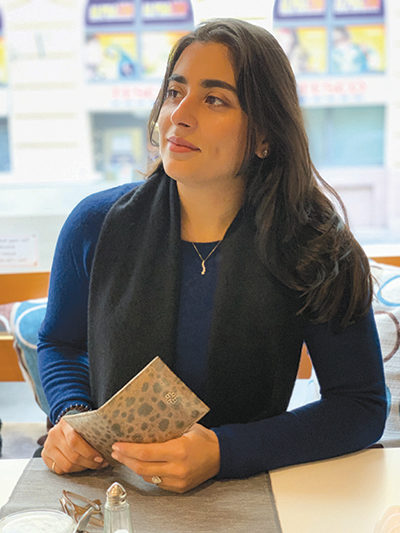
Mayura Davda-Shah MS’16
Fishing for Sustainability
Vogue India featured Mayura Davda-Shah MS’16 in an article on eco-friendly fabric. Davda-Shah uses sustainable fish skin leather for her Mayu collection of luxury accessories. Alternative leathers, she said in the article, “are certainly offering the next big wave of innovative, sustainable material options for new-age design houses like ours.”
]]>So when Wilson, who works a day job at a tech startup, was casting about for an entrepreneurial idea, sneakers seemed a natural fit. But not just any sneakers. Artefact NYC makes products for the former sneaker-head who has outgrown tennis shoes and needs sophisticated footwear that moves seamlessly from the workweek to the weekend, says Wilson.
Make no mistake: The company’s signature sneaker, dubbed No. 85, is not meant for the gym. Wilson runs down the details: Italian leathers that get better with age, durable rubber soles, waxed laces, and a sleek, refined profile. He thought he knew a lot about sneakers before embarking on the process, but he soon found out there was quite a bit more to learn. Wilson says, “There were lots of late nights plotting and planning. I definitely know more about leather—nubuck, suede, pigskin, how smooth, how buttery, how durable. I know a ton more about leather.”
He also knows a ton more about launching a startup involving small-batch manufacturing. One of the biggest challenges, he says, was finding a manufacturer who was willing to make shoes in small production runs. To enhance the product’s aura of exclusivity, only about 100 pairs of each color are made—and when they’re gone, they’re gone. Artefact created a special model for curated men’s clothing website Grailed; it sold out quickly and is now in demand on the resale market.
Wilson says the rise of independent fashion brands, with products sold directly to consumers, helped inspire Artefact; such brands, he says, are “having a moment.” But he also gives a tip of the hat, as it were, to Babson: “My education was both practical and inspiring. Babson has a special culture, a motivating culture. I don’t know if that exists anywhere else.”—Jane Dornbusch
]]>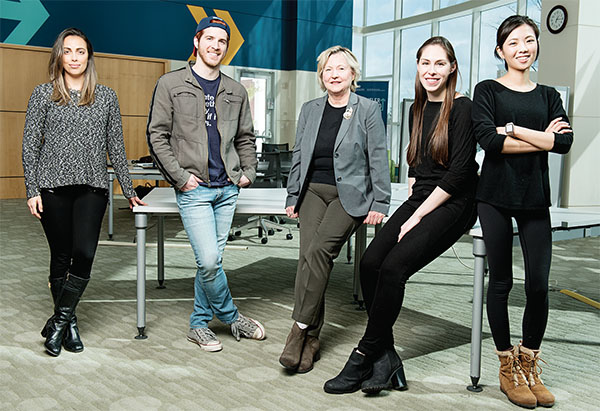
Photo: Webb Chappell
FEI director Caroline Daniels (center) with members (from left) Marcella Urso, Chad Caisse, Carrie Hecker, and Shu-Ning Hsu, all MBA’18
Caroline Daniels, senior lecturer in entrepreneurship, became aware of a pent-up demand for fashion and apparel education in the spring of 2016, when she taught a class on future trends. Given an open-ended assignment to study an industry, a good third of the class chose to focus on fashion. Encouraged by their enthusiasm, Daniels—supported by a few grad students—put together a “fashion discussion table” on campus that fall to gauge interest.
“We expected maybe 30 people,” says Daniels. “Eighty showed up.” Thus was born the Fashion Entrepreneurial Initiative. FEI brings in high-profile speakers and has hosted numerous events on campus, ranging from a student fashion show to an annual “Future of Fashion” panel. This past winter, FEI partnered with the Digital Experience Initiative, the Babson Marketing Club, and the Babson IoT Club for a two-day “Imagine-a-Thon,” in which teams of students worked to “re-create the theme park experience for the home.” Nigel Simpson, director of tech strategy for The Walt Disney Co., served as one of the judges. Then in April, the group hosted an action tank to discuss environmental challenges facing the fashion industry with Kathryn Hilderbrand, founder and CEO of Good Clothing Co.
Clearly, the group’s brief is broad. But the push toward fashion at Babson is about much more than style. Students, who largely drive the FEI agenda, are interested in all aspects of the apparel industry, from production to labor practices to sustainability to retail and distribution models. “One of our main goals,” says Carrie Hecker, MBA’18, “is to let undergrads and grads know there are many other areas of fashion they can get involved in.”
February’s Imagine-a-Thon aptly demonstrated the breadth of FEI’s mission. Student teams had 24 hours to come up with a project and a prototype; the winner posited a “magic box” that could enhance the experience of streaming videos by adding such ambient effects as wind, fog, flashing lights, and aromas. Fun, but is it fashion? “The question really was about all the sensory elements that add up to Disney, and that very much does include fashion,” says Chad Caisse, MBA’18, an FEI member who participated in the event. “The princess costumes alone are huge.”
FEI also looks at fashion through a more conventional design lens. Its members are excited about the Weissman Foundry, currently under construction on campus, which will provide resources for hands-on projects; Daniels and the FEI team worked to ensure that the new makerspace includes a fashion room where students can hone their fabricating skills. But iconoclasm and disruption are baked into the idea of FEI. “What the fashion industry needs,” says Caisse, “are people who question the fashion industry—question its schedule and its process and its ideals and bring it into a new age. And I think there is the brain power here at Babson to do that.”
FEI was created, at least in part, to help disseminate that message. Says Daniels: “We’re building toward leading-edge education experiences around fashion business models. We’re going to show the world that we have a global fashion community.”—Jane Dornbusch
]]>“The timing of the information was frighteningly slow,” recalls Lynch, a 36-year veteran of clothing retailers, including Gap and Ann Inc. Currently, he’s president and CEO of Justice, a specialty retailer of young girls (ages 7 to 14) apparel and lifestyle products with more than 950 stores in the United States and 17 countries. “Today, everything’s instantaneous and complete and comprehensive.”
Lynch receives interim day readings with such information as foot traffic, the number of items in each purchase, the cost of each purchase, and the margins on each product.
“I know where we are during the day in all 950 stores,” he says. “It’s just a whole different ballgame.”
It’s an Omnichannel World
Monumental shifts have been going on in retail, say Babson alumni working in the industry. Changing the way retailers approach business are the explosion of digital commerce and the emergence of the omnichannel model, the latter of which acknowledges that customers are just as likely to shop on a laptop in their kitchen or from their phones as they are to drive to a store on a Saturday afternoon.
“Omnichannel has been revolutionary for the industry,” says Justin MacFarlane ’94, chief strategy, analytics, and innovation officer for Macy’s, the iconic department store. For more than a decade, MacFarlane was a management consultant for apparel manufacturers and retailers, and then he worked for Ann Inc. before joining Macy’s. “The industry had operated in a very linear way for a hundred years, and almost overnight we changed all that.”
Gone are the days when customer service meant simply staffing the store with responsive sales associates or hiring friendly, efficient people to answer phones at a catalog call center. Those elements are still important, say alumni, but retailers have had to revamp their businesses significantly to accommodate digital devices.
At Justice, Lynch and his team are focused on finding new ways to blend the digital and store experiences to make them seamless. For example, everything sold in Justice stores is available online, but the retailer also offers additional inventory as web-only products. So during the back-to-school shopping season this past summer, Justice rolled out an orderin- store option. Sales associates and store signs alert customers to the online products, viewable on their phones or an in-store computer. Customers then can pay for goods at the store register and arrange for them to be shipped home. “In the omni world, if you go into the store, you should be able to purchase any product that’s online,” Lynch says.
Many omnichannel retailers also provide the option of ordering products online and picking them up at a nearby store, notes Eileen Rizzo, MBA’97, senior vice president for omnichannel process and systems at Macy’s. This option appeals to customers who want to avoid shipping costs, prefer to pay cash, like to try on clothes before they buy, or just want their items fast. “There’s the immediacy of it,” Rizzo says. “If I’m browsing online at 9 a.m. and I want to wear it tonight, that’s really convenient.”
A 20-year retail veteran, Rizzo has worked as an industry consultant, as well as for Joan & David (a now-defunct shoe company) and J.C. Penney. She remembers when Amazon jump-started e-commerce in the 1990s. Retail companies wanted in on the game but built their dot-com businesses as separate entities, Rizzo says. Given that in-store and online customers were often the same people, that separation became problematic. Macy’s shifted its strategy around 2010, devoting resources to a blended, omnichannel approach. Today, while Macy’s has announced a recent spate of store closings, it is among the top five online retailers in the country, according to a 2016 Women’s Wear Daily ranking.
The Cost of Remaining Competitive
The transition to omnichannel has been expensive, alumni note, requiring major investments in infrastructure, such as building facilities to handle distribution. The services that customers have come to expect, including fast and low-cost (or free) shipping, increase costs for the retailer as well. “We’re constantly playing with and testing out the right level of inventory and where you put that inventory to be closest to the customer so we can reduce the cost of getting it to them,” Rizzo says.
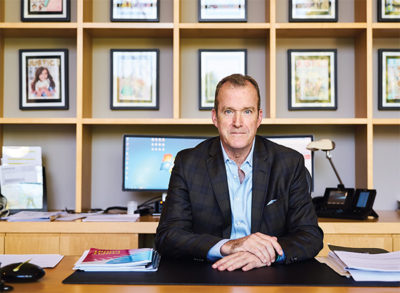
Photo: Chris Langer
Brian Lynch of Justice
Retailers also need to stay ahead of the so-called “digital natives,” the younger generation who grew up using digital devices and balk at buggy apps or nonintuitive navigation. Mobile is “a big focus of what we’re doing today,” says Lynch of Justice. “The content must be native to these devices, so that the screenshot looks good, it fits on the phones people have, and is easily readable and accessible.”
Christopher Disa, MBA’11, director of global merchandising for women at Gap, says Gap customers in China didn’t really use desktop computers for e-commerce, but they recently went “from 0 to 60” in adopting mobile phones for making purchases. He notes that retailers are working to ensure customers get what they need in China and elsewhere, even when they’re using a small, hand-held screen.
Garnet Hill, a mainly mail-order retailer that specializes in women and kids fashion, as well as home products, receives roughly 86 percent of its sales transactions via the web and mobile devices, says Sandi Summerson, MBA’11, senior vice president and general merchandise manager. The other 14 percent of sales comes from phone orders and retail locations, including Garnet Hill’s outlet at its corporate headquarters in Franconia, New Hampshire. But the driver behind most of the company’s sales, even those coming from the web, is its deluxe catalogs, which feature Zen still-life covers and lavish photography. “We want to create something beautiful that the customer can read like a book,” Summerson says. So the company mails an estimated 40 million catalogs to customers each year, a significant investment.
Even in the digital age, catalogs remain an important tool for many companies, Summerson says. An 18-year veteran of L.L.Bean, where she led the women, kids, and home divisions, Summerson moved to the Sundance Catalog in Utah before she was hired by Garnet Hill nearly two years ago. She notes that in the early 2000s, multiple retailers, including Lands’ End, made the strategic decision to scale back their catalogs to cut costs, assuming customers would find the company online. But sales dropped significantly, forcing them to bring back the catalogs.
The Power of Analytics
Figuring out who customers are and what they prefer, such as a fondness for perusing catalogs, always has been pivotal to making smart strategic decisions. Today, however, alumni say the explosion of data available about customers and their purchasing habits has transformed strategy. Retailers know not only what clothes customers buy, but also such specifics as the brands they prefer, if they’re switching loyalty to other brands, and which price points and markdowns prompt them to buy. “This has been a big change over the last 10 years,” says MacFarlane of Macy’s. His team includes doctorate-level data scientists who analyze the reams of information now available about customers and their behavior. “These scientists are really helping us understand the power of our data and are unearthing pockets of competitive advantage.”
Summerson says that Garnet Hill has similarly detailed data about its customers. Retailers also can garner customer information through loyalty programs and private label credit cards, including how many times a year a customer makes a purchase. Summerson offers the example of kids clothing and backpacks, products she worked with in the past at L.L.Bean and now at Garnet Hill. “We have a huge backpack business at back-to-school time,” she says. “Many of these buyers purchase only the backpack, and nothing else.” Adding those customers to the catalog mailing list didn’t pay off. “Once we were able to analyze this data and target more valuable buyers, our mailing became much more productive,” she says.
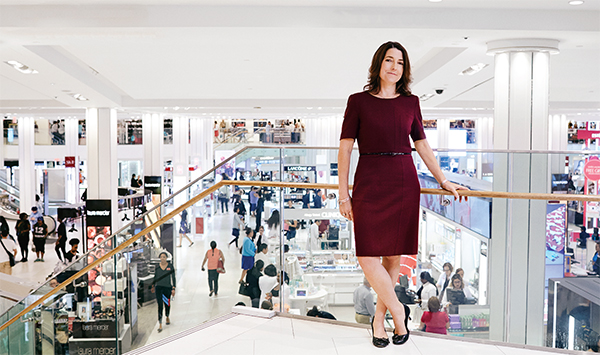
Photo: Winnie Au
Eileen Rizzo, MBA’97, senior vice president for omnichannel process and systems at Macy’s
Rizzo of Macy’s adds that many retailers supplement in-house data with stats from The NPD Group, a market research firm that collects information about other companies’ customer transactions. “It’s a way of knowing what customers are doing in your competitive set so you can identify the opportunities to improve your business, and where you’re getting beat by your competition,” she says.
Retailers also are combining analytics with new technologies, hoping they can tempt customers to make purchases. Rizzo and her team currently are working to place radio-frequency beacons in stores to scan for shoppers with the Macy’s app on their phones. The company then can identify the shopper and know her history, including the fact that she was looking at a particular brand of shoes on its app the previous week. “Say she just walked into the store and happens to be in the shoe department,” Rizzo says. “I’m going to send her phone a 20 percent-off coupon good for the next hour on a pair of shoes.” Research shows that millennial customers respond especially well to this type of personalization, she says.
While the advantages of analyzing trends in customer data are clear, Disa of Gap believes it’s important not to be chained to the numbers and to supplement data with information gathered through simple observations. Disa, whose experience includes stints with Talbots and Puma, says he has taken his team on field trips to high schools at dismissal time to see what kids are wearing, and visited competitors’ stores to see how their assortment compared to his company’s. This kind of information gathering can inspire surprises that customers love, he says. “If it was only analytical, then it would be automated in a sense,” Disa says. “You can’t just look at numbers.”
MacFarlane agrees. Analytics provide valuable insights, but that data must be combined with knowledge that comes from experienced, savvy retail buyers. “It has to be blended,” says MacFarlane, “with merchants working together with the data scientists.”
What Customers Want
The central question that strategists use all this data to answer remains: What does the customer want? Lynch, who joined Justice a little more than a year ago, notes that the company has been in the midst of a turnaround. Part of that process was learning that the pricing structure was not working for its customers. Lynch’s team conducted extensive market research, including surveys and focus groups, and found that mothers, who typically get the final say in how much money will be spent, were turned off by Justice’s prices. “We had a lot of complicated promotions,” says Lynch, “and our initial tickets placed us as being the most expensive retailer in the category.”
Ultimately, the company arrived at new, more competitive prices, identifying some core products as “style buys” that never go on sale, while placing other items on sale periodically, but less often than before. “All of it has worked very, very well,” Lynch says.
Macy’s also is simplifying its price structure, rethinking its approach to markdowns and coupons. “Customers tell us that our pricing can be confusing,” MacFarlane says. “We’re working to alleviate that pain point for sure.”
At the same time, trends suggest that shoppers are hungry for deals, Rizzo says. She points to the increasing popularity of off-price retailers—T.J. Maxx, Marshalls, Burlington Coat Factory—where garments are a season or two behind and sell for lower prices. In response, Macy’s launched Backstage, its own off-price stores.
The emergence of “fast fashion,” made popular by retailers such as Zara and H&M, which produce new products swiftly and cheaply, also puts pressure on retailers to respond to trends more quickly. Social media, especially visual apps such as Instagram, make it easy for customers to see what people are wearing around the world and immediately seek similar styles. Most retailers typically need up to nine months to get products from design to the customer’s cart, Rizzo notes, but Spanish company Zara can get new designs to stores in a matter of weeks, in part by designing, manufacturing, and distributing from facilities located close together in Europe.
To compete with this fast pace, other retailers are developing tools that streamline the process of planning, designing, and manufacturing as well. “Fast fashion has forced us, in a good way, to become more agile from a supply chain standpoint so that we can provide the freshness and fashionable products that people are expecting,” MacFarlane says. New items in Inc. and Style&Co., two of Macy’s private brands, now reach stores in as little as four months, Rizzo adds.
Soon after Summerson arrived at Garnet Hill, the company introduced an integrated calendar tool that allows staff members to see how their decisions will impact others across the organization. For example, because the company offers certain core products every season, it can work with vendors to start the manufacturing process early, taking advantage of factory downtimes to get better pricing and, thus, wider margins. “If we’re behind in our design cycles and haven’t solidified our colors and silhouettes and miss our deadline to take advantage of our production cycle, we negatively impact our margins,” she says.
This system also helps ensure that the company stocks what customers want. The tool is used in weekly meetings, when merchandising, inventory, and supply chain teams meet to review business of the previous week and compare it with sales forecasts. “We discuss high-supply and low-supply inventory and areas of risk, along with suggested strategies to mitigate impact across the organization,” Summerson explains.
Inspiring Loyalty
The key to staying relevant in this ever-evolving environment, say alumni, is producing products that people can’t get elsewhere, maintaining direct relationships with customers, and inspiring loyalty. “It still cycles back to the customer and what unreplicable experience, service, or product you can offer that separates you from your competitors and makes you the go-to place,” Lynch says.
Summerson admires Urban Outfitters, a retailer that she believes has managed to stay relevant even though its customers age out of its demographic after just a few years. Urban Outfitters acquired the majority of The Vetri Family group of restaurants, including the chain Pizzeria Vetri, in 2015. Plans for the acquisition include opening Pizzeria Vetri locations next to Urban Outfitters and sister stores Anthropologie and Free People in malls, creating what the industry dubs brand clusters. “Brands are seeking ways to differentiate themselves through these experiences,” Summerson says.
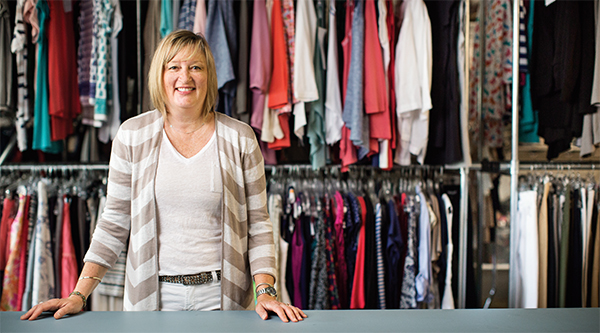
Photo: Tom Kates
Sandi Summerson, MBA’11, senior vice president and general merchandise manager, Garnet Hill
Similarly, Garnet Hill has launched several ventures to create new experiences for its customers. This past summer the company introduced a mobile boutique, a repurposed shipping container outfitted with a miniature retail space offering clothing and home goods. The boutique, which can be moved to different locations, is designed to bring the catalog and lifestyle components of the brand to life, Summerson says. “This is a new idea that no one else is doing,” she says, “and we were able to create some buzz in traditional and social media.” The container boutique also is helping the company test the possibility of opening retail stores in various locations.
Garnet Hill already opened a store in Bridgehampton, New York, two summers ago. Although it has long run an outlet at its corporate headquarters, this type of store was a first for the catalog company. “Our original concept for the New York store was a pop-up in a rented space in Bridgehampton,” Summerson says. The goal was to sell products and run events that would boost brand awareness. But as word about the store spread and customer excitement grew, the company opted to open a more permanent space. “The response to the store was phenomenal and outpaced expectations,” she says.
To be competitive, clothing retailers will keep trying new ways to connect with their customers, say alumni, emphasizing that the success of digital commerce doesn’t spell the end of the store. Rather, the future of retail is about integrating all the tools at a brand’s disposal. “Retailers are pretty hard on themselves, but the transformation of omnichannel over the past five years has been incredible throughout the industry,” MacFarlane notes. “We sometimes forget we’ve only been doing this for four or five years, and the evolution of the integration of physical and digital is only in the first inning.”
Erin O’Donnell is a freelance writer in Milwaukee.
]]>Bouchareb grew up thousands of miles away from Casablanca in Rock Island, Illinois, a small Midwest town surrounded by cornfields. But her father was from Morocco and her mother from Switzerland. Entrepreneurs in the hospitality industry, they had followed one of Bouchareb’s uncles to the Midwest to run their own business. To some in her community, Bouchareb had a strange background. “People didn’t know where Morocco was,” she says.
Bouchareb, however, would spend most summers traveling with her family to her parents’ homelands, one year vacationing in Morocco and the next in Switzerland. As Bouchareb and her two brothers grew older, sometimes her parents would split for the summer and let the kids choose which country to visit. “I loved going to Morocco,” says Bouchareb. “I like the culture, how warm the people are. There is a rustic beauty, and everything is very colorful, from the rugs to the pottery to everything you use on a daily basis.”
Bouchareb’s deep connection with her Moroccan roots helped inspire Amal Oils, the company she founded in 2010 that sells beauty products based on ancient Moroccan customs and made by local women. While studying at Babson, Bouchareb was introduced to social entrepreneurship, and upon graduating she wanted to found a socially responsible, sustainable company. At first she went to Peru, where a friend lived, to explore the idea of creating a micro-lending firm, but she quickly realized that the learning curve of a new language and culture was too steep. So she decided to go back to what she knew and felt comfortable with, the country and people of Morocco.
To explore ideas for a business, she traveled through Morocco for several months with a guide to help her with the languages. (In Morocco, people speak Arabic, French, and Berber languages, says Bouchareb, who speaks French and understands some Arabic.) “People thought I was a little crazy, doing a road trip to these rural areas,” she says, “but I was meeting wonderful women along the way.”
In one region where native argan trees grow, she encountered a beauty oil made by a women’s cooperative. The women would harvest and dry fruit from the argan trees, remove the skin to retrieve a nut, crack the nut to get at the small kernel inside, and press that kernel to extract its oil. The resulting liquid was then filtered and decanted to remove impurities before bottling. Moroccan women use the oil, which is naturally rich in vitamins and antioxidants, to enrich and restore their hair and skin.
The village where the women live was tiny, with dirt roads and clay buildings, and the women sold their product when the market was open and they had time to spare from their families. “There wasn’t a strong commerce going on in this town, but the women were really trying to do something,” says Bouchareb. The cooperative had been granted space to produce their goods, but what they needed was help with distribution. “At the time, the U.S. market for oils and beauty products was growing,” says Bouchareb, who decided this was the business for which she’d been searching. So she founded Amal Oils (amal means hope in Arabic) to sell the cooperative’s argan oil to the U.S. market.
Since starting the company, Bouchareb has helped the cooperative grow from eight women to more than 30, and she has expanded its offerings to include beauty products typical of other Moroccan customs. For instance, the company sells soaps, masks, and scrubs used in the hammam. To connect with the women and keep up on the business, Bouchareb tries to travel to Morocco twice a year. She also trained a cooperative member to handle the financing and accounting.
Besides paying the women for creating the products, Bouchareb donates a percentage of her profits to the cooperative. “Part of my intention was to allow the women to grow their own business and understand how to manage that growth,” she says. The money has been used to buy a machine to help with cold pressing the oil; the women also have given back to their community by helping build a school and park with the profits. “Oftentimes, these women are making more than their husbands,” says Bouchareb, “which doesn’t happen very often in Morocco.”
Although business initially had been strong, competition has made sales more difficult of late. Bouchareb has other commitments that demand her time as well, including a full-time job at Burger King headquarters. She also co-founded a new online apparel company, Quina, which sells T-shirts made from Peruvian cotton. So she admits that she’s not sure what the future looks like for Amal Oils, noting U.S. demand will play a big factor. To spur demand, she connects the women with other companies around the world interested in their products.
“I like helping these women see the impact that earning money can have on their lives,” she says. “They found a product and skill that they can do, and it has helped them come out of a not so desirable situation. It is very powerful, being able to see other people become entrepreneurs and contribute in some small way to somebody else’s success.”
Sharing Skills, Unearthing Talents
Growing up in New Delhi, one of the world’s most populated cities, gave Gayatri Jolly ’11 a sense of gratitude and appreciation for what she has been given in life. The prosperous and cosmopolitan capital also is home to numerous migrants who come in search of work and better access to an education. With little to call their own, many of these migrants live in the infamous slums scattered throughout the heart of the city. “People live in 10-by-10-foot homes, and up to 10 family members are sharing that space,” says Jolly. “They don’t have electricity. They don’t have clean drinking water. They may only get one meal a day, and it may not be nutritious. They don’t have access to health care.”
Jolly doesn’t just know of the slums. She has connected with people in these communities for more than 10 years as a volunteer for Adharshila, the NGO her mother co-founded. Adharshila aims to improve the lives of New Delhi’s underprivileged people, mainly women, through such initiatives as free skill development, health care, and education. In high school when her mother started the NGO, Jolly and her sister would help in whatever way was needed. Sometimes they would assist with technology, such as using Word to create a funding proposal. Other times they would help set up for an event, such as a festival or holiday celebration. Often, they would go into the communities to persuade skeptical residents to attend the free classes.
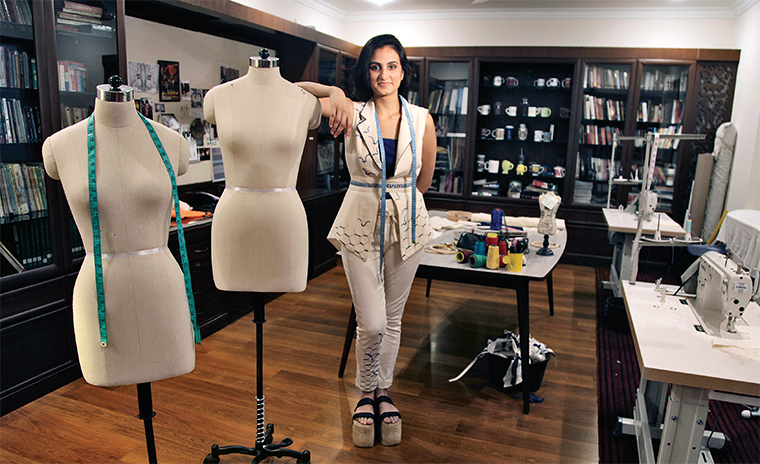
Photo: Aditya Kapoor
Gayatri Jolly ’11 in the design studio for her eponymous brand
When Jolly came to the States to attend Babson, she began looking at the NGO through the lens of entrepreneurship. “Being surrounded by so many ambitious students, you start thinking in an entrepreneurial manner,” she says. “It made me realize that I needed to empower these women and help give them the opportunity to start their own businesses. Because what differentiates me from these women is opportunity. It’s not that they can’t do it. They need the means.”
One of the many programs offered by Adharshila is cutting and tailoring, a common service in New Delhi. “In India you have access to tailors who come to your home for a lot less money than it would cost in the U.S.,” says Jolly. Fashion was always a passion of Jolly, who remembers experimenting with her own designs for clothes as a youth. She would come up with a concept, buy materials, and then the family tailor would make the outfit. “Sometimes it worked, and sometimes it was a disaster,” she says. She and a cousin talked about one day going to Paris and New York City to be fashion designers.
After graduating from Babson, Jolly, following her interests, talked to her mother about creating an entrepreneurship development program at Adharshila, starting with the cutting and tailoring class. In addition to basic skills, the new program would give the women sewing machines and offer mentoring. “We’d talk to them about how much money to charge for what they are making, what labor and fabric are worth, how to reach out to customers and get more business, how to make sure their quality is good,” says Jolly.
While working closely with the program, Jolly also came to a self-realization. “I needed to give design a chance,” she says. After graduating from Babson, she had worked with her father in the family business for a year and a half, and he had trained her in all aspects of how the business operated. But she knew that she wanted to study fashion. “In India, people used to think if you’re going into the arts, you must not be good at anything else,” she says. “But my father believed in me and said I’ll invest in you.”
She applied to and has since graduated from Parsons School of Design at The New School in New York City, and she has her own design firm, Gayatri Jolly. Focusing on costume design, she counts singers, DJs, and other artists as her typical clients. “I’ve started developing a brand,” she says. “I love seeing the journey of other artists and translating that into a garment.”
Jolly has brought the skills she honed at Parsons to Adharshila as well. On her first summer break back in New Delhi, she met with the NGO’s teachers and updated the curriculum for the cutting and tailoring program, creating two sections, one for basic skills and another for advanced, and she taught the teachers the techniques she had learned. While at Parsons, she organized donations for Adharshila, collecting tools and fabric scraps from students and mailing them to India. After graduating, she started conducting workshops on subjects such as draping, embellishment, and how to deconstruct old garments to create new items. She also is bringing a design perspective into the curriculum at the request of the participants.
The women participating in the program show tremendous promise, notes Jolly. She recalls a woman’s day held by the NGO that was sponsored by Air India. The airline donated 10 saris worn by their in-flight hostesses, and Jolly challenged the advanced cutting and tailoring group to use the uniforms to create as many outfits as possible with no waste. The women came up with 15 outfits, which were then showcased in a fashion show featuring women pilots from Air India. “The women who had designed the clothes came down the runway holding hands with the women pilots,” says Jolly. “Everyone in the audience started clapping. After that, there was this aura of confidence from the women in the program.”
Knowing the importance of having someone who believes in you, Jolly offered an internship at her studio to one promising young woman who wanted to study design but couldn’t afford school. “She already had learned the basics from our program. I’d seen her and trusted her and invited her to intern,” she says. “But she spoke to her family, then came back and said she didn’t want the job. Her family wasn’t behind her. It was heartbreaking.”
In some communities, women are not encouraged to be independent, says Jolly. “We once had to move out of a community overnight because the men didn’t like what we were doing and it was unsafe,” she says. “But that is not typical. Like with any outsider, people are wary, but then they warm up once they understand that we’re not going to take anything from them. We just want to give. Come once, and let us show you what we can teach you.”
Jolly hopes to offer women the chance to use their talents in her collections one day, noting how women from different parts of India bring unique skills, such as embroidery and weaving, from those regions. “They have these skills, but they don’t think they have value. So the skills are becoming extinct,” she says. “I want to encourage them and help them get jobs. I’ll do workshops and have them do different mock-ups. It provides me with inspiration, and when they make products for me, I pay them. They get to use their creativity, and I try to show them, this craft is coming from you.”
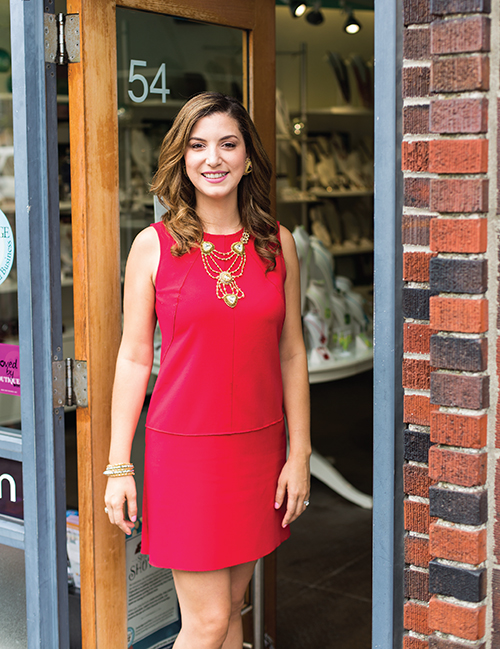
Photo: Pat Piasecki
Esmeralda Lambert, MBA’11, in front of what would soon become her flagship retail store, Esmeralda
Staying Put, but Coming Home
Esmeralda Lambert, MBA’11, grew up in the Dominican Republic with entrepreneurial parents. When Lambert was a toddler, her father, a former national cycling champion and civil engineer, and mother opened a retail bicycling shop, Aro & Pedal, in Santo Domingo where they lived. Lambert, the second of five children, remembers helping out in the store from a young age. “My older sister and I worked at the shop every summer and Christmas,” says Lambert. “I was about 8 years old, and we used to fill up the tires with an air pump. And at Christmas, when people would leave the store, we had to ask for the invoice and confirm their orders.”
Focused on high-end gear, the shop flourished and today has five locations as well as its own line of products. When Lambert was 15, she sometimes traveled to trade shows in the U.S. with her father to meet with vendors. Having studied English for years, she acted as a translator for her Spanish-speaking father. Upon graduating from high school, Lambert worked full time for the company, earning her undergraduate degree in business in the usual four years by attending classes at night. Although her days were long, often ending in the early morning hours, she loved being able to apply many of the concepts she learned to her job.
Lambert’s father had started her as a cashier, but she slowly worked her way through the company, taking on various roles. She helped out in the computer department and then moved into international purchasing, again traveling with her father and acting as a translator with vendors. “I learned a lot,” she says. “My father is an amazing negotiator.” She moved into accounting, then operations, and then sales, each time improving the company’s performance.
Four years out of college, she was ready for her next challenge and came to Babson to earn an MBA. “My parents were like go get your MBA, and then come back to the Dominican with fresh ideas, with a new way of doing business, and we’ll start something new,” she says.
But a kink ended the plan: Lambert fell in love with classmate Matt Lambert, MBA’11. “I was afraid to tell my father that I wasn’t coming back. He’s such a good negotiator, I thought he would convince me to go back,” she says, laughing. “He only had one request, that the first week of every year I be in the Dominican. It’s Three Kings Day and the busiest season for my parents’ business.”
Lambert agreed. She and Matt were married and settled in Medford, Massachusetts, and Lambert took a job as a product manager at a nearby company. That holiday season, as promised, the couple traveled to the Dominican to help out with the rush. The visit left Lambert’s mind racing with ideas. “It was so empowering to be in the family business again,” she says. “It was so much work, because you work crazy hours, but it was so different than my work here. I went from this calm, 9-to-5 job to this week in my parent’s crazy business. It was so invigorating.”
On the plane ride home, Lambert told her husband that she intended to start her own business. He asked in what, and she answered, jewelry. “Everybody always compliments my jewelry, and it’s all made by women in the Dominican, and I had so many people that wanted to buy what I was wearing, so I’m going to start a jewelry company,” she says. “Matt said OK. Literally, that’s how it started.”
While still in flight, the two wrote some ideas on their iPad, and during a layover in North Carolina, Lambert called her mother. “I said, ‘Hey, mom, I’m starting a business.’ She asked, ‘In what?’ And then I told her, and mom said, ‘I love the idea, this is perfect. We can start with jewelry, then we go into purses, to belts.’ In two seconds, she had an idea of a whole big brand,” says Lambert. “I was like OK, OK, let’s start with jewelry.”
Lambert’s business has come a long way since its inception. Working with her mother, Lambert has hired seven artisans in the Dominican Republic who collaborate with her on designs and make the jewelry. Lambert realizes that she easily could have found artisans closer to her U.S. home, but she wanted a business with ties to her roots. “I told my husband that I came to Babson to start my business in the Dominican,” she says. “There is so much talent there, and there are so many really good people who just needed the chance.”
For the first few years, Lambert sold her collection through her website as well as craft fairs and festivals. She also negotiated her way into 30 retail stores. This fall, she is branching out, opening a retail store in Harvard Square, Cambridge. She is looking forward to having a place not only to showcase her products but also to interact with customers. “I want to hear directly from the people who are wearing my jewelry,” she says.
As the company grows, Lambert hopes to hire more Dominican artisans. To that end, she has established a system in which lead artisans can hire and train other artisans as needed. “The whole idea is for these women to be able to get other women within their communities to grow our network. The lead artisans will manage their teams,” says Lambert. “These women are so talented, but it was tough for them to actually make a living out of this. We help them earn a steady income.”
A longer term goal is to be in a position where she can donate 10 percent of the business’s profits to a worthy cause in her homeland. Lambert has seen poverty, she says. Both her parents grew up in low- income families in the countryside, which she visited as a youth and remembers fondly. But she hasn’t seen the extreme poverty that she knows also exists. “I have an aunt who has dedicated her life to helping people,” she says. “She goes to places where kids have literally nothing and helps out directly. I hope with this new venture we’re able to do that. Who knows, if I go with my 10 percent, maybe I can motivate others to go and help, too.”
]]>
Photo: George Kamper
Astrid Pedregal ’07 at home on the beach in Miami.
Astrid Pedregal ’07 loves sunshine and warm temperatures, so much so that the Venezuelan native moved to Miami after graduating from Babson. Of all the warm cities in the world, she chose Miami in part because of fond memories from childhood trips to visit family in the vibrant city, and her sister, Alexandra, lived there as well.
Pedregal was working for the financial services company, UBS, but, a year later, it relocated her to New York City. Away from the tropical metropolis she had come to adore, Pedregal felt out of place. “New York is a great city, but I just didn’t feel like I could be myself,” she says. “I remember how sad it was after Labor Day that you couldn’t wear white. I wore my white linen dress, and everyone looked at me weird. They were wearing boots already!”

Photo: George Kamper
Pedregal works on designs with her sister and partner, Alexandra.
She worked for three years in New York City before finally convincing UBS to transfer her back to Miami. Throughout these moves, Pedregal and her sister talked about starting a business together. Being entrepreneurial, the two wanted to give their own business a try but couldn’t settle on the right idea. Then while vacationing with her boyfriend on the swanky Caribbean island of Canouan a few years ago, Pedregal found herself checking out the men—their swimwear, to be exact. “They were all wearing very boring swimsuits, including my boyfriend,” she says.
Solid colors, stripes, and low-quality fabrics abounded. Sensing an opportunity, she immediately called her sister, and the two began hatching plans for a luxury swimwear brand for men. Within two months, Pedregal left her job and devoted herself full time to the new company, which they named Crasqi for an island off the coast of Venezuela. Crasqi swim shorts feature vibrant colors and patterns and a trimmer profile than most swim trunks. “Shorter is better,” Pedregal says. “Men usually have nice legs, so why hide them under long, unflattering shorts?”
Many men spend most of their lives restricted to the “typical corporate uniform of black, grey, and brown,” Pedregal says. The bright colors of Crasqi trunks offer an opportunity for them to cut loose. Says Pedregal, “Summer is all about the freedom to be who you really are.”
The toughest part of running Crasqi, says Pedregal, is the uncertainty that comes with any startup. “We constantly have to make decisions based on assumptions,” she says. “Sometimes we’re right, sometimes we’re wrong. The key is to celebrate when we’re right and not lose the enthusiasm when we’re wrong.”
The best perk related to her new venture? Pedregal loves what counts as a business trip. She and her sister (Crasqi’s creative director) traveled this summer to Europe to expand the reach of their brand, which already is available in upscale men’s clothing stores in Miami and luxury boutiques at various beach resorts. Their first stop was Florence, Italy, for Pitti Immagine Uomo, a men’s clothing trade show, and then they visited summer hot spots to meet with retailers. And, of course, their itinerary included time in the sand. “When we go to the beach, even if we’re relaxing, we’re still working,” she says. “It’s a great way to do research.”—Erin O’Donnell
]]>Pulling over, she contemplated what to do. She could think of no good options. Her cellphone didn’t have service, and the landscape outside her windshield was dry, barren, and full of cactuses. Aside from an occasional tractor-trailer passing by, she was alone. On the road ahead lay more tight curves, with skimpy guardrails on one side and frightening cliffs on the other.
With no better choice, she decided to keep going. Easing the van back on to the interstate, she coasted down the road. “I couldn’t do anything but get out of the mountains,” she says. “I hoped I wouldn’t pick up enough speed to go over the edge.”
Hession’s job, and her life, is the road. As the founder and owner of Aeri Rose, she designs and makes women’s clothing inspired by nature and fairies. She has no office. She doesn’t even have a regular place that she calls home. Instead, the entrepreneur travels most months of the year, selling her clothes at festivals across the country. Hession admits that such a nomadic existence can be wearying. She sometimes daydreams about being settled, about saving in a 401(k) and buying furniture, about not driving so much and having to deal with overheated brakes (a mishap that, fortunately, ended without incident).
But while Hession may not have taken the standard route in her career, she is living life on her terms. Like other bold alumni not afraid to venture off the beaten path, she is unconventional, passionate, and following the beat of her own drummer. “So far, the benefits of a traditional job have not outweighed what I’m doing,” she says. “Starting this business was the best choice I ever made.”
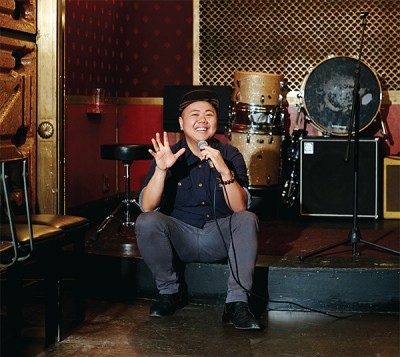
Photo: Winnie Au
Slam poet Kit Yan performs at venues across the country.
The Poet
As the real world beckoned after graduation, Kit Yan ’06 tried working in an office. He had one job in insurance, another in real estate development. He didn’t stay at either for long. “I don’t think I’m suited for a desk job,” says the Brooklyn, N.Y., resident. “I couldn’t stand being in one place for one day. When your heart is somewhere else, it’s hard to concentrate. My heart is with poetry.”
Performing more than 100 times a year at colleges and other venues across the country, Yan works as a slam poet. Poetry obviously is not the most lucrative pursuit, but he has found a way to make it work. “This has been my full-time job for the past eight years,” says Yan, who makes money from selling tickets and merchandise, such as ties, tote bags, and CDs of his poetry. He also teaches poetry and performance in workshops, and he sometimes writes poems and lyrics on commission.
Yan’s love of words can be traced back to his childhood. Growing up in Hawaii, he often heard people use the phrase “talk story.” Hawaiians value the art of storytelling, the simple pleasure of friends hanging out and swapping tales. This suited Yan. “I was kind of a loud-mouthed kid,” he says. “I was always talking.” He also was always writing poems. Friendship was a frequent subject. In his fourth-grade yearbook, he remembers writing poems about memories and the school year.
At Babson, Yan took poetry classes with English professor Mary Pinard. Besides teaching about the fundamentals of poetry, she gave the class an assignment that would change Yan’s life: attend an off-campus poetry reading. Yan stopped by a poetry slam, something he had never seen before. A poetry competition where poets perform rather than read their words, slams are dramatic and intense. “I was absolutely mesmerized by how strong the delivery was,” Yan says. “It was so expressive. It was powerful. It was moving, captivating.”
Soon Yan was performing at poetry slams in Boston and Cambridge. He wasn’t good at first, and the scores he received from slam judges were terrible. “I was nervous,” he says. “I didn’t have a lot of confidence.” Yan kept working at it. On campus, he often was seen walking around and reciting poems out loud. “I was always doing it,” he says. “I was obsessed.”
Yan steadily improved, and he wasn’t afraid to tackle issues in his poems that were very personal. During his time at Babson, Yan wrestled with issues of gender and identity and ultimately began describing himself as a transgender person (individuals whose gender identity differs from the sex they were assigned at birth). “I was trying to figure it out,” he says. “I was always talking about gender, body, sexuality.” These subjects remain a major part of his poems today. Many might feel squeamish talking about such private matters on stage, but Yan feels he has no choice. He’s a poet. He must talk about something. Why not that? “This is just part of who I am,” he says. “It’s something I deal with every day.”
Yan realizes that poems about being a transgender person might not appeal to everyone, and he doesn’t care. “I make art for my audience, my community,” he says. “I do not tailor art to the mainstream. I don’t need to create a work of art that everyone can relate to.” That being said, he knows that many people aren’t familiar with gender identity issues, and he hopes his words might reach some of them. “I have the opportunity to move someone’s heart and change their mind,” he says.
Yan confesses that while he was at Babson, he wondered if it was the right place for him. Perhaps an art school would be more appropriate, he often thought. But now he is grateful for the education he received. It’s essential. When working on his art, he usually thinks of it in business terms. Rehearsal is product development, the audience is his customer, and the stories he tells are his product line. “One of the main reasons I’m able to be a full-time artist is I have a business background,” he says.
The art and business of poetry continue to keep Yan busy. Beyond the constant touring, he’s currently working on new pieces for his stage show, and he has a forthcoming book from Trans-Genre Press. He also is co-creating a musical, Interstate, which has been a long process. Four years have passed, and its debut is still a way off. “It’s gone through a lot of drafts,” Yan says. All this makes for a hectic life, but Yan relishes the creative freedom, artistic integrity, and happiness his career affords him. These rewards are invaluable. “They can’t be measured in money,” he says.
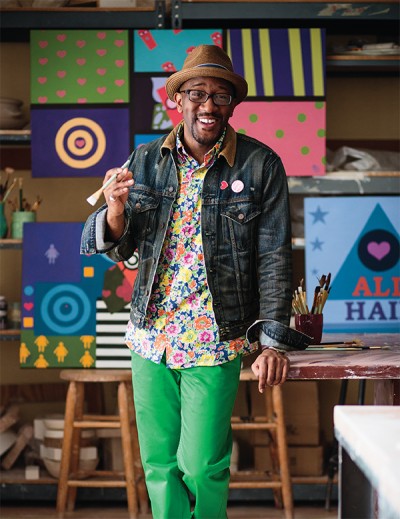
Photo: Pat Piasecki
Painter Jamaal Eversley stands with some of his work.
The Painter
Picking Jamaal Eversley ’10 out of a group of people isn’t difficult. Find the sharp dresser with the bold colors, the man looking showy yet classy, a mix of Prince and Sinatra. “Colors bring everything to life,” Eversley says. But while his wardrobe grabs attention, he insists that’s not his intention. “This is who I am. It’s not, ‘look at me.’ It’s, ‘this is me,’” says the Randolph, Mass., resident. “It’s not about standing out. It’s about being comfortable. You’re not in the back. You’re in the forefront.”
Eversley is a painter. It’s not the easiest choice for a career. To earn some extra spending money, he works a part-time job or two, including manning the perfume counter at Nordstrom’s. He also lives with his mom. Eversley is well aware of the more typical path that people take with their lives—they go to college, get a nice job, and then settle down with a spouse, kids, and a house. But that well-worn road isn’t for him. “I’m trying a road that is less traveled,” he says. “I’m trying to do what’s in my heart.”
Art has been part of Eversley’s life for a long time. He enjoyed drawing with the colored pencils his mom gave him in the fourth grade, and he took art classes in high school. He found painting and drawing to be a peaceful, meditative process. When he came to Babson, though, he intended to put art aside. “At the time, I wanted to go to Wall Street and make lots of money and be in nice suits,” he says.
Then as a first-year, he was walking outside and came upon a drawing class taught by artist-in-residence Danielle Krcmar. He stopped. The class wasn’t what he expected at a business school. “What the hell?” he asked her. “There’s art here?” Eversley became fast friends with Krcmar and soon was attending all the exhibits and events he could find on campus: plays, poetry readings, dance performances. “I went to all of that,” he says. “All forms of art spoke to me.” Eventually he began painting again, and he had a big exhibit on campus his senior year. Not many in his life knew that he was such a serious artist. His mother came to the exhibit opening and was stunned. “When she saw the work I had there, she was thinking there’s more to this guy than I thought I knew,” Eversley says.
When he graduated, Eversley wanted to live a life centered around art in some way. At first, he focused more on acting than painting. He attended the Stella Adler Studio of Acting in New York and acted in community theater productions and student films. He also appeared as an extra in big-screen movies, including Ted and American Hustle. But Eversley came to a realization. Acting is like trying out for a sports team, he says. If you’re picked for a part, that’s great. If you’re not picked, you’re stuck on the sidelines. “You’re a boy with a football and no one to throw it to,” he says.
Deciding to make painting his priority once again, Eversley found some recognition with his work exhibiting at galleries, colleges, and libraries. But one big obstacle still loomed if he wanted to be a successful, full-time artist: debt. To pay off his car and student loans, he took a full-time job in 2014 and also added a couple of part-time gigs. All the working, though, made him tired. He struggled in his free time to find the energy to paint. “Why am I doing this?” he asked himself. “I want to be creating. I want to be inspiring people. I feel like I’m dying, not doing what I’m supposed to do.”
So Eversley quit the full-time job. He now has more time to paint, of course, but also to apply for grants and residences and to think about his brand. Many artists don’t think of themselves as having a brand, says Eversley, but that’s because they didn’t have the advantage of a business school education. “Babson made me realize it’s all business,” Eversley says. “Your career is about your art. But it’s also about building a brand around it.” One of his artistic heroes is Andy Warhol. Eversley admires not only the originality of the pop artist’s work but also his marketing. Think of Andy Warhol, he says, and you think of both his art and his persona. Warhol’s look and his life are as much a part of the painter’s brand as his distinctive paintings. “He was a marketing expert,” Eversley says.
To help create a brand for himself, Eversley currently is working on a series of paintings united by a similar feel. The series, called Love Ballads, features simple yet striking imagery: hearts, polka dots, arrows, stripes, and a character that he calls the Nerd. And much in the way that Eversley dresses, the paintings will be loaded with bright colors. He thinks that such a fun, flashy look is in fashion now. “This is the time. Look at sneakers. Look at the colors of pants,” says Eversley, who hopes the works will have a wide appeal. “I want art that is universal, that can touch everyone somehow.”
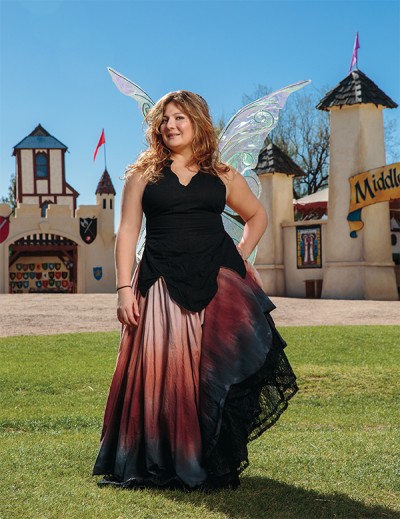
Photo: Chris Hinkle
A designer of clothes inspired by nature and fairies, Erica Hession, MSM’10, sells her wares at Renaissance fairs and other festivals.
The Designer
Throughout much of the year, clothing designer Erica Hession lives a gypsy life, hopping from festival to festival across the country. She began the year with an eight-week stop in Arizona, followed by another eight-week stop in Texas. Treks to Virginia, Pennsylvania, New York, and Maryland come next. During the busy festival days, she interacts with customers and sells her Aeri Rose clothes, while at night she winds down with fellow vendors. “We sit around a campfire swapping stories, playing music, and enjoying each other’s company,” she says.
Hession sells clothes at a variety of events, including art, music, and Irish festivals, but her main business is at Renaissance fairs, fanciful happenings that conjure up the times of lords, ladies, and knights. Dressing up in costume, eating turkey legs, and watching jousts are all standard Renaissance fair activities. So is shopping. “On the surface, it may seem silly. You’ll see a castle wall, and people are trying to talk with bad accents,” Hession says. “But to me, if you look past the silliness, you see the festivals as a place full of entrepreneurs and artists. There is a community of traveling artists who are making a living doing this.”
Hession makes and sells skirts, dresses, and summery tops. Flowing and colorful, they look like clothes that fairies might wear for a frolic through the forest. “I’m selling fun and whimsy and a carefree time to customers,” Hession says. Buying such clothes is a different shopping experience from what many women are used to; this isn’t a department store. “I feel when women go shopping, it’s this weird, bittersweet thing, because while they like buying new clothes, they don’t like trying them on—the clothes are made for models,” Hession says. Dress like a fairy, however, and that self-consciousness frequently melts away. “They allow themselves a lot more liberty in choosing colors and cuts and styles,” she says. Hession often dresses as a fairy at the festivals, though she’s also practical. One can’t don a tutu and wings all the time. “You can’t go to the grocery store dressed like that,” she says. “Maybe you can if you’re 5.”
Hession first kicked around the idea of selling clothes as an undergraduate business student at Drexel University. She and her roommate were interested in the green movement and wanted to start a company that would repurpose old clothing into new styles. “That idea didn’t really get far out of the living room,” she says. After receiving her master’s degree in global entrepreneurship from Babson, though, Hession was eager to give the entrepreneurial life a whirl. “Being surrounded by entrepreneurial types whose favorite question is ‘what if’ is really exciting and inspiring,” she says. Hession dusted off the idea of starting a clothing company, and Renaissance fairs seemed like a good market to tap. Growing up in Maryland, Hession worked at the state’s Renaissance fair in high school and college, so she knew about the community of vendors who traveled with the festivals. As someone with a strong case of wanderlust, she saw their lives as an intriguing way to live.
Hession launched her business in 2011. At first, it grew slowly, though that didn’t bother her. Not sure if the venture was something she wanted to pursue for the long haul, she was content seeing the country and meeting interesting people. “I was floating around,” she says. “That was enough.” In time, though, Aeri Rose grew, as did Hession’s commitment and ambition. Today, business is strong enough that she sometimes sets up a team to sell her wares at fairs she can’t attend herself. She also has added necklaces to her product line, written a children’s book, The Gift of the White Elephant, with an accompanying audio book, and even put together a runway collection that was inspired by circuses for Baltimore Fashion Week last year.
All this success, however, has created a problem. By herself, Hession makes all the clothes that she sells, but her busy travel schedule only leaves so much time for production. “My inventory constraints are limiting my growth,” she says. “I want to get away from making everything myself.” She has thought about taking production overseas, though she would like to continue manufacturing in America. She fantasizes about owning a townhouse in a city like Philadelphia. The basement could be her workshop, and she could hire a seamstress. The first floor could be her storefront, while the top floors could be her living space. After so many miles on the road, a home base to run her business and settle down a bit sounds appealing. “It would be nice to find a place where I can put something down, and it’ll be there when I get back,” she says.
Not that she’s ready to give up traveling completely. Hession describes her life and career as the “scenic route.” She still relishes seeing places and meeting people, particularly her customers. “I feel like I would miss that, if I was locked away in an office with no direct contact with the customers that keep the business alive,” she says. “I am grateful to each and every supporter.”
]]>Sneakers also have captured the imagination of many from the Babson community, who give us a peek into this fun, fast-paced industry.
]]>Since their humble beginnings in the 1800s, sneakers, supposedly named for the stealthy quiet of their rubber soles, have captured the fancy of people around the world. In 2013, the global market for sneakers reached $55 billion, according to an analysis in Forbes, with about 40 percent of those sales in the U.S.
Sneakers also have captured the imagination of many from the Babson community, who give us a peek into this fun, fast-paced industry.
Rick Blackshaw ’85
President, Sperry Top-Sider, Lexington, Mass.
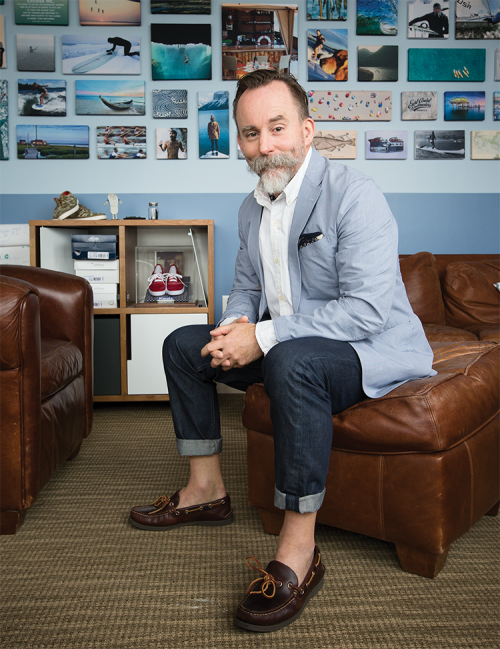
Rick Blackshaw ’85 in his office at Wolverine Worldwide.
For more than 20 years, Rick Blackshaw has worked in the footwear business, mostly focusing on sneakers. As a result, he has spent many hours trying to figure out the mindset of 13- to 24-year-olds. With two sets of teenage twins, 17-year-old daughters and 14-year-old sons (the boys are identical), he has somewhat of a home-field advantage. “I’ve learned a lot by peppering my children with questions every night at the dinner table,” he says.
Blackshaw says understanding young people at a deep level, and then responding with products that capture their imaginations before the competition does, remains one of the biggest challenges in this field. He currently works for Wolverine Worldwide, a global footwear and apparel company with 15 brands, as president of Sperry Top-Sider. Before that, he was president of Keds, also owned by Wolverine.
As president of Sperry, Blackshaw has a hand in most areas of its business, from product design to domestic and international distribution to brand management. The iconic Sperry Top-Sider dates back to 1935, when Paul Sperry invented his first pair of boat shoes. Blackshaw and his team currently are working to relaunch Sperry Top-Sider with a new brand identity; fresh strategies for its print, digital, and social media marketing; and a redesign of all stores. The new Sperry is looking for a stronger connection to young consumers, he says, with a focus that’s more “nautical grit” and less yacht club.
Igniting consumer passion takes a multifaceted approach in this era of social and digital media. “People obviously have access to information that they didn’t have before,” Blackshaw says. “From a trend perspective, say you’re a kid in Indiana who has no cool sneaker shops anywhere near you. Ten years ago, whatever your local sneaker retailer had was all you really knew about. Today with different blogs and websites, you can know everything that happened on the runway in Paris or London or Stockholm and buy something very similar in short order. Consumers just have more options. You have to really lodge your brand in their hearts and minds.”
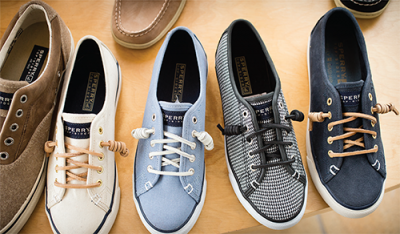
Blackshaw believes in the staying power of iconic brands. He gives the example of Converse, where he served as vice president/general manager of the Chuck Taylor group. “When I got there in 2004, the prevailing wisdom was that there was a seven-year boom-and-bust to that shoe,” he says. When consumer demand waned, the company would drop the price of the shoe, which “would make it appear less cool.” The company sold about 2 million pairs of Chuck Taylors in 2002, and 10 years later, it sold 75 million pairs annually. “We found that if you’re able to connect to the hearts and minds of the consumers through great products as well as great marketing,” Blackshaw says, “you can defy any supposed cycle.”
When Blackshaw was president of Keds, he also made savvy moves to connect young girls and women with the brand, such as signing singer Taylor Swift as spokesperson. The process of wooing Swift took months. Blackshaw sensed that her management team was worried the Keds brand was too small for the megastar to endorse. In the end, though, Swift signed on because she had worn Keds as a child, and she liked the brand’s marketing campaign about bravery, which meshed well with her songs. “She occupies a very unique place for girls 13 to 24,” Blackshaw says. “Not only is she an incredible talent as a musician, songwriter, and performer, but she also happens to be a fashion icon.”
Blackshaw himself is known for his personal style. Bloomberg Businessweek recently featured him in its “What I Wear to Work” column, including a photo of Blackshaw wearing an ascot, vintage vest, jeans, and a pair of Sperry Top-Siders (of course). Blackshaw jokingly calls his look “aristocratic hobo.”
Clearly, Blackshaw fits well in the footwear business. “It’s a lot of fun,” he says, “because it combines fashion, design, marketing, and consumer insight.” Although sneakers may have been around for more than a century, the category still holds tremendous potential, he notes. The secret to growth, Blackshaw believes: “Making that connection of product and brand and consumer.”
Monica Ballin, MBA’12
Marketing Manager, Converse, North Andover, Mass.

Monica Ballin, MBA’12, shows off one of her many pairs of Converse sneakers.
Monica Ballin has an awesome sneaker collection, which she admits benefits from her job. As a Converse marketing manager who wears a size 7, the company’s sample size, she often scores free sneakers—not to mention the pairs she buys with her employee discount. “My closet is obnoxious,” she says.
Her current favorite pair is the Platform Plus, a wedge sneaker that came out in spring 2014. “I really like the height, and they’re so comfortable,” she says. Another favorite pair is the recently released Lux. “It’s another sneaker with a wedge but with a slightly shorter shaft, making it look even better on your foot,” she says.
Before working in the sneaker industry, Ballin was at a boutique PR firm in Los Angeles. A desire to reboot her career and focus on more tangible products brought her to the Babson MBA program. A previous brief stint at Reebok had introduced her to the athletic shoe industry, which she loved, and she initially hoped her MBA would help her land a job in product development at a similar company. But then she decided to focus on marketing instead.
Now in her third year at Converse, Ballin says she made the right move. “Footwear is something I’m passionate about,” she says. “Not only do I get to work in footwear, but I also work for a brand that I’ve loved since I was a teenager and that I connect with as a consumer.”
Ballin is part of a team that oversees the North American marketing for Converse’s Jack Purcell franchise, one of the company’s four main product lines alongside Chuck Taylor All Star, Cons, and Kids. She handles “everything from soup to nuts,” which means being part of a team that creates marketing plans for the brand and wholesale partners.
“Converse’s success has been their consumer-led focus, in which all decisions are based on the needs of the consumer,” says Ballin. The Chuck Taylor All Star, once popular as a basketball shoe, now is considered a lifestyle sneaker. Its customers tend to be involved in creative expression, such as art or music. The typical Cons customers are more interested in the skateboard culture. The Jack Purcell franchise is named for a Canadian badminton player who designed the shoe in 1935 to wear on the badminton court. “Jack Purcell consumers are obsessed with the details and quality of the product,” she says. “They crave comfort, craft, and versatility in their footwear.”
Ballin says the strength of the Converse brand makes her job especially fun. “Our brand is well-known and understood by consumers, and we have products that people love,” says Ballin. “It just makes my job a lot more enjoyable, because we are marketing an authentic message. We’re not trying to convince them to buy anything at the end of the day.”
Steven Keating, MBA’15
Head of Design for Running/Training, Puma, Boston
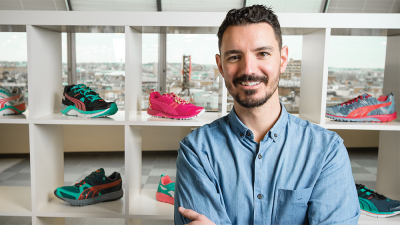
Steven Keating, MBA’15, in the downtown Boston office of Puma.
As head of design for running and training sneakers at Puma, Steven Keating once flew to Iceland during the winter to conduct wear-testing with an elite Swedish runner. Keating hung off the side of a Land Rover in freezing temperatures to keep up with the runner and find out how the shoes felt.
But ask Keating what his biggest challenge is, and he’ll answer that it’s leading a team of designers. As creative, imaginative people, designers “find inspiration in many different ways and don’t always follow the rules,” he says with a laugh.
Keating started his career in sneakers working for Saucony, which is known for its running shoes. Soon after graduating with a bachelor’s degree in graphic design, he accepted an internship creating catalogs and other marketing materials at the company. As the internship drew to a close, the senior vice president of marketing and products invited Keating to step into an open position on the footwear design team on a trial basis. Within six months, he was a permanent member of the team.
He found the switch from 2-D to 3-D exciting. “Graphic design is all about the layouts and composition,” Keating says. “All of a sudden, I had to make a brain shift to doing the same thing in three dimensions, and making a product that people rely on to prevent injury while running. It adds a lot of complexity to the process, and that’s one of the things I love about it.”
Keating left Saucony for a new opportunity at Puma in 2010 and was soon promoted to his current position. But he sensed that he needed stronger business and management skills, so in 2013, he began earning his MBA. “I knew the design side of things,” he says, “but I didn’t really know the overall business, and I just wanted to become a better manager.”
Putting his education to work right away, Keating established a mentorship program in the design department that has become a model for the rest of the company. He tries to foster a fun atmosphere in the office, citing the “serious arsenal of Nerf guns” that gets frequent use. He and his team once watched a documentary about mid-century modern designers Ray and Charles Eames and then began sketching shoe ideas based on the couple’s iconic Eames rocker and lounger. “I need to increase revenue for the company, but I also need to keep a design team happy and keep them motivated and inspired,” he says. “These two things sometimes are really hard to manage.”
At Saucony, Keating worked on technical shoes for runners. At Puma, he says, “We ride this knife edge of technicality and lifestyle. So we have two consumers in mind while designing: The guy who is training to run a marathon, and the consumer who will wear the shoe with jeans and just wants to look really good.” Signs of success for Keating: Puma’s Faas 100 v3 running shoe recently received high marks from Runner’s World magazine and also was chosen as the top sneaker by Hypebeast, an online style magazine for men.
Customer demands have changed rapidly during the last 10 years, says Keating. When he started at Saucony, the company emphasized big, overbuilt, technical shoes with plenty of cushioning. That changed dramatically with the popularity of the Vibram FiveFingers, thin-soled shoes meant to mimic the sensation of running barefoot. In response, companies created super-minimal, low-profile, light shoes. Since then, however, “the pendulum is swinging back,” says Keating, “so that people are asking for a bit more support, a bit more protection.”
As a head of design, Keating has had the chance to work with top international runners. Before the 2012 Summer Olympics, he traveled to Jamaica to give sprinter Usain Bolt a presentation on the shoes Puma designed for him to wear during the games. (Puma uses a 3-D scan of Bolt’s feet to build his shoes, says Keating, and the iridescent white color of Bolt’s Olympic shoes was selected to contrast with the blue track.)
He also makes periodic trips to Vietnam to meet with manufacturers and visits countries just for style inspiration. He has traveled to 15 countries in the three years since joining Puma, an especially impressive feat given his wife recently had a baby and he has been juggling the Babson program for the last 18 months. On a recent trip to Amsterdam, Keating gathered with about 30 other Puma designers to talk trends and shape the creative direction for the autumn-winter 2016 lines. “Trips like that remind me how much fun my job is,” he says. “Not every day is like that, but I get a lot more days like this than most people, so I feel lucky.”
Barry Katz, MBA’09
Founder, Ektio, Bridgewater, N.J.

Photo: Winnie Au
Barry Katz, MBA’09, tries out his Ektio sneakers on the basketball court.
Barry Katz is on a mission to prevent the top injury among basketball players: ankle sprains. When he was a basketball player in high school and college, Katz suffered three severe ankle sprains on the court. Now a radiologist with expertise in orthopedics, he knows that repeated ankle sprains can end a player’s career.
So Katz founded Ektio, which makes a basketball shoe designed to prevent ankle sprains. Most sprains occur when players jump and then land on someone else’s foot, says Katz. The foot rolls over on this uneven surface, triggering the sprain. Katz blames typical basketball shoes for making the situation worse; as the player lands, the shoe moves one way, and the foot goes the other.
He teamed up with an orthopedic surgeon and podiatrist to develop his shoes, which keep the foot stable and prevent rollovers. Ektio shoes include two built-in straps, one that crosses the ankle joint and one that wraps all the way around the ankle. “This really locks your foot into the shoe,” Katz says. The outer edge of each shoe includes “outriggers” or bumpers to further prevent rollover. “There’s no other solution on the market right now that can reliably reduce or prevent ankle sprains,” Katz says. “Wearing tape and braces doesn’t generally prevent ankle injuries, because you are still wearing a shoe that can roll over.”
While he was an MBA student at Babson, Katz explored the Ektio idea with a group of classmates, and they made the shoe the focus of their capstone project. After graduation in 2009, Katz continued to pursue the idea while working full time as a radiologist. He sold his first pair in November 2010 and since then has sold upwards of 18,000 more. In addition to Ektio’s website, the shoes are available online from Champs, Dick’s Sporting Goods, Amazon, and Eastbay.
Katz has introduced new models every few years, incorporating improvements each time. The most recent, the Alexio, has more durable midsole and outsole layers. “In our shoes, the foot becomes part of the shoe, which means you’re putting a lot of stress on the shoe when you make short stops and bursts,” Katz says. He and his team also changed the strap configuration to make the shoe easier to put on.
Ektio has just three permanent employees: Katz; his son, John, an MBA student at New York University who handles sales and marketing; and his wife, Carol, who handles operations and billing. Other work, such as sneaker design and manufacturing, currently is handled by freelance consultants. Katz would like to hire more employees to help grow the business, but he has found raising enough capital to be difficult. “Of course, it’s always a challenge,” Katz says, but he suspects that investors may be wary of investing in such a competitive space. So Katz is planning to launch a crowdfunding campaign on Kickstarter this year.
He has big plans. Katz wants to use this technology in other types of shoes, including construction boots, hiking boots, and shoes for tennis and volleyball, and he’s also looking for potential licensing partners. “I know our product is going to help people,” he says. “It’s going to help people who have never sprained an ankle to protect their ankles. And if people have had a sprain, this is going to give them the opportunity to play sports with much more confidence.”
Kira Zaiger, MBA’04
Senior Manager, Sourcing, Business Operations, New Balance, Lawrence, Mass.
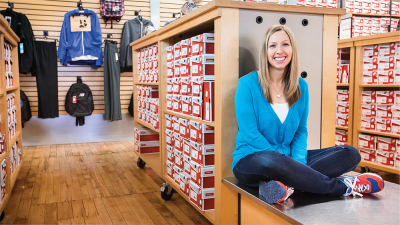
Kira Zaiger, MBA’04, in one of New Balance’s outlet stores.
For Kira Zaiger, working in the athletic shoe industry means watching out for floods in Indonesia, monitoring strife in Vietnam, and planning around the New Year in China.
Zaiger manages the team that handles sourced manufacturing for all New Balance shoes. She and her colleagues determine which factories are available to produce the right number of shoes in the right time frame. Then they oversee production to ensure shipments leave the factories on time. Although one out of every four pairs of shoes that New Balance sells in the U.S. is made or assembled here, many are manufactured in Asia, which means Zaiger has to consider current conditions in these countries as she and her team make decisions.
Chinese New Year, for example, challenges anyone doing business in China, Zaiger says. Workers travel to visit their families for the February holiday, and factories generally shut down for two to three weeks. Complicating matters, New Balance has a high-capacity requirement in February for autumn and winter products. So Zaiger’s team works hard to prepare for these hurdles. “We try to get better at it every year,” she says, “but there always seems to be something new to add to the situation.”
After working many years in the apparel industry for companies such as Talbots and Liz Claiborne, Zaiger joined New Balance almost three years ago, making her “a relative newbie.” The last year has been particularly challenging for the company, but in a good way. “We’ve experienced incredible growth this year, which is great, but a lot of it happened very fast,” she says. “This year has been about ramping up capacity to address the greater demand.”
The company’s international markets have taken off, especially in Japan and China. “The brand has really caught fire,” says Zaiger. Expectations are for this growth to continue, and Zaiger will help plan for the brand’s global future.
New Balance is growing in the United States as well, driven in part by ramped-up marketing campaigns. The big news in Boston last year was that Red Sox slugger David Ortiz switched his endorsement to New Balance, says Zaiger. As New Englanders, she and her colleagues find it fun watching Red Sox games to try to see who else is wearing New Balance cleats, and she has grown skilled at spotting her company’s shoes at a distance. “It’s funny. It’s now more of a test to see if I can tell which style it is,” she says.
In her three years in the sneaker business, Zaiger has noticed an emphasis on lean manufacturing over the quest to find cheaper workers. The lean approach involves improving productivity with automation, new management approaches, and designs that are easier to manufacture. “You can’t continue to chase cheap labor,” Zaiger says, especially while maintaining New Balance’s quality standards and desire to be socially responsible, which includes ensuring safe conditions for factory workers.
Zaiger travels to Asia up to three times a year. The visits remind her of how many people are involved in the process of manufacturing a sneaker. “You walk into these factories, and there are thousands of people who are building these shoes,” she says. “There’s someone who’s touching every single part of the shoe.”
Thinking about all the stages a sneaker goes through until it reaches the customer can boggle the mind, says Zaiger. Going from initial design concept to store displays, when hopefully the sneaker’s style is trending in popularity, takes about 18 months. “It’s almost amazing when it’s done correctly,” she says. “Sometimes when I see the shoe on someone’s foot, I think, ‘Oh, my gosh. I know the whole story there.’”
]]>